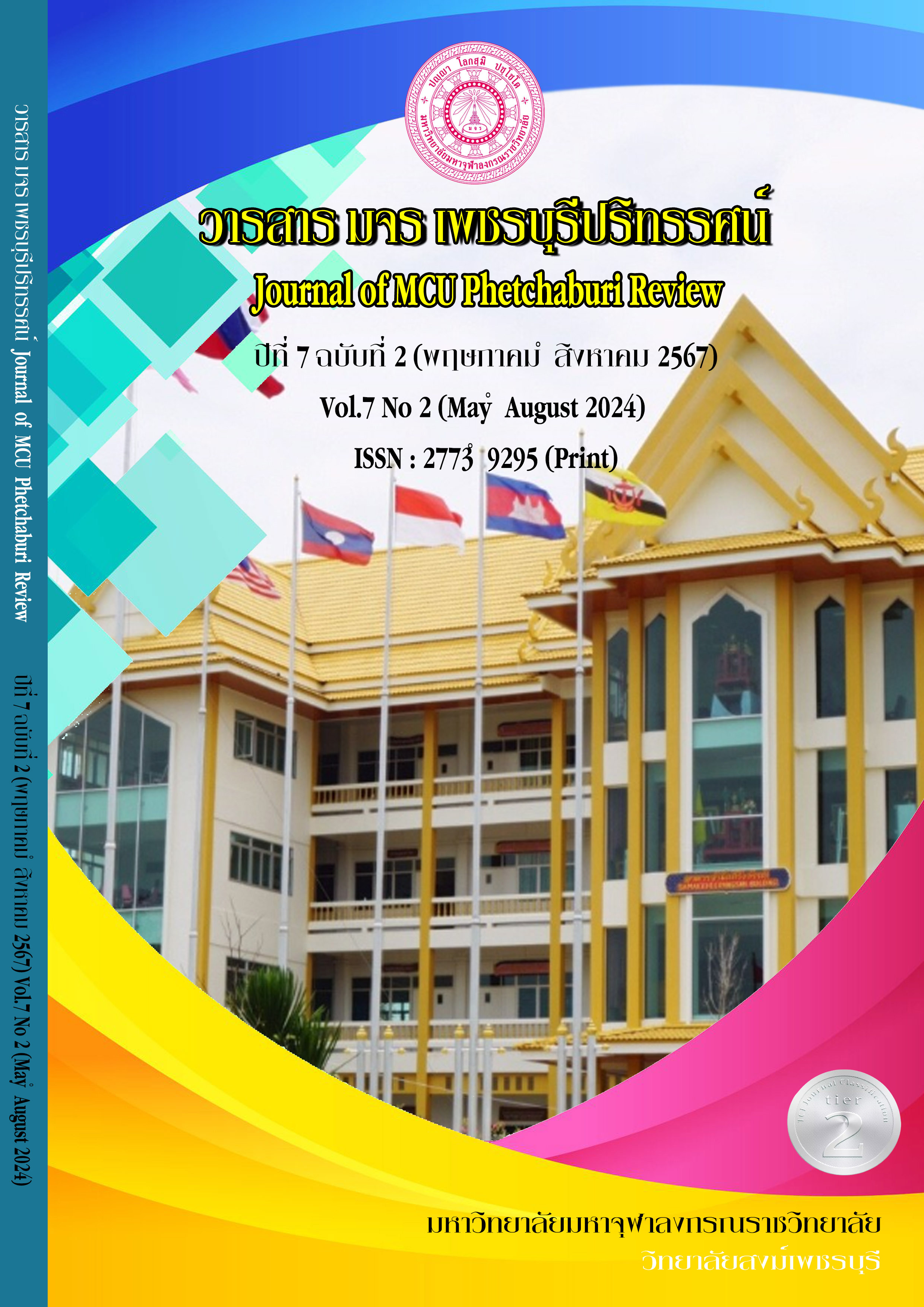Integrated Marketing Communication Strategies to Promote Sports Tourism
Main Article Content
Abstract
The study is Mixed-Method research aiming 1) To explore the condition of integrated marketing communication to promote sport tourism, 2) To simulate the causal factor structural equation model of integrated marketing communications that influence image of promoting sports tourism, 3) To present an integrated marketing communication strategy on promoting the image of sports tourism. In-depth interviews and focus group discussions and structural equation modeling SEM techniques were used. By collecting data from Thai tourists traveled to participate in running activities to promote tourism. Using a purposive selection method of 450 people, the research results showed that the causal model integrated marketing communication strategies to promote the image of sports tourism after improvement were consistent with empirical data. Relative chi-square ratio Relative (Relative Chi square Ratio: 2 /df) is equal to .380, RMSEA is equal to .016, (CFI) is equal to .999, harmonization (GFI) is equal to .973 The model acceptance index (TLI) was .94, the relative consistency (NFI) was .982, and from adjusting integrated marketing communication strategies to promote the image of sports tourism make the values harmonize to get the appropriate model. Assumptions are in harmony with empirical data, reasonably good level which is consistent with the qualitative research, it was found that Integrated marketing communication combines more than one type of marketing tool and integrates online and offline channels by considering 1) goals 2) identity 3) integration. 4) unity 5) Participation The sport tourism must get cooperation with the community and stakeholders.
Article Details

This work is licensed under a Creative Commons Attribution-NonCommercial-NoDerivatives 4.0 International License.
References
กระทรวงการท่องเที่ยวและกีฬา. (2560). ยุทธศาสตร์กระทรวงการท่องเที่ยวและกีฬา ฉบับที่ 4 (พ.ศ. 2560 – 2564). กรุงเทพ: กระทรวงการท่องเที่ยวและกีฬา.
การกีฬาแห่งประเทศไทย กระทรวงการท่องเที่ยวและกีฬา. (2564). แผนยุทธศาสตร์การกีฬาแห่งประเทศไทย (พ.ศ. 2564 - 2570). กรุงเทพ: การกีฬาแห่งประเทศไทย กระทรวงการท่องเที่ยวและกีฬา.
ปิยพงษ์ สัจจาพิทักษ์. (2560). อิทธิพลของการสื่อสารทางการตลาดแบบบูรณาการและความน่าเชื่อถือของเว็บไซต์ที่มีต่อความไว้วางใจของผู้บริโภคในตลาดกลางพาณิชย์อิเล็กทรอนิกส์ของสินค้าโอทอป. มหาวิทยาลัยศิลปากร. นครปฐม.
วิรัญชนา ใจสม. (2560). การศึกษาปัจจัยการรับรู้สื่อสังคมออนไลน์ที่ส่งผลต่อการตัดสินใจเดินทางท่องเที่ยวของนักท่องเที่ยวชาวไทย. มหาวิทยาลัยกรุงเทพ. กรุงเทพฯ.
ศิริวรรณ เสรีรัตน์ และคณะ. (2552). การบริหารตลาดยุคใหม่. พัฒนาศึกษา:กรุงเทพฯ.
เสรี วงษ์มณฑา. (2547). เทคนิคการสื่อสารการตลาด. วิสิทธิ์พัฒนา:กรุงเทพฯ.
อัฐพล วุฒิศักดิ์สกุล. (2560). การสื่อสารการตลาดดิจิทัลกับการตัดสินใจใช้บริการขนส่งออนไลน์ (Online Messengers) ผ่านแอพพลิเคชั่น ของผู้บริโภคในเขตกรุงเทพมหานคร [Independent Studies - Master, มหาวิทยาลัยกรุงเทพ]. กรุงเทพ.
Fazri, A. (2022). PROSES KOMUNIKASI PEMASARAN TERINTEGRASI DALAM PEMBENTUKAN PERSONAL BRAND SEBAGAI STRATEGI PENJUALAN PRODUK UMKM (STUDI DESKRIPTIF PADA UMKM CAKE BY NADIA). Jurnal Manajemen Terapan dan Keuangan, 11(2), 359-371.
Gibson, H. J. (1998). Sport tourism: a critical analysis of research. Sport management review, 1(1), 45-76.
Gray, E. R., & Balmer, J. M. (1998). Managing corporate image and corporate reputation. Long range planning, 31(5), 695-702.
Hemmonsbey, J. D., & Tichaawa, T. M. (2018). The effects of major sport event leveraging for tourism and destination branding: The case of South Africa as an emerging destination. GeoJournal of Tourism and Geosites 4(12)L 33-44.
Koc, E., & Ayyildiz, A. Y. (2021). Culture’s influence on the design and delivery of the marketing mix elements in tourism and hospitality. Sustainability, 13(21), 11630.
Kotler, P. (2003). Marketing insights from A to Z: 80 concepts every manager needs to know. London:John Wiley & Sons.
Lu, C.-S., Weng, H.-K., Chen, S.-Y., Chiu, C. W., Ma, H. Y., Mak, K. W., & Yeung, T. C. (2020). How port aesthetics affect destination image, tourist satisfaction and tourist loyalty? Maritime Business Review, 5(2), 211-228.
Mansfeld, Y. (1992). Tourism: Towards a behavioural approach. Oxford:Pergamon Press Oxford.
Morfoulaki, M., Myrovali, G., Kotoula, K.-M., Karagiorgos, T., & Alexandris, K. (2023). Sport Tourism as Driving Force for Destinations’ Sustainability. Sustainability, 15(3), 2445.
Prayogo, R. R., & Kusumawardhani, A. (2017). Examining relationships of destination image, service quality, e-WOM, and revisit intention to Sabang Island, Indonesia. APMBA (Asia Pacific Management and Business Application), 5(2), 89-102.
Pytharoulakis, M., & Zouni, G. (2020). Lobbyscape: A framework about the effect of hotel lobbies’ atmospheric elements on customer satisfaction. Research in Hospitality Management, 10(2), 107-115.
Rovinelli R. J. and Hambleton R. K. (1977). On the Use of Content Specialists in the Assessment of Criterion-Referenced Test Item Validity. Dutch Journal of Educational Research, 2(2), 49-60.
Sampson, P. M. (1967). Commonsense in qualitative research. Journal of the Market Research Society, 9(1), 30-38.
Schultz, T. P. (1993). Mortality decline in the low-income world: causes and consequences. The American Economic Review, 83(2), 337-342.
Schultz, T. P. (1994). Human capital, family planning, and their effects on population growth. The American Economic Review, 84(2), 255-260.
Smith, P. R., & Zook, Z. (2019). Marketing communications: Integrating online and offline, customer engagement and digital technologies. New Delhi:Kogan Page Publishers.
Standeven J. & De Knop P. (1999). Sport tourism. Champaign:BluePort Publishing.
Tibebe, G., & Ayenew, T. (2018). The effectiveness of integrated marketing communication for high involvement product purchase decision: In case of University of Gondar employees. Pacific Business Review International, 11(4), 17-29.
Vanichbuncha K. (2014). Statistical analysis: statistics for administration and research (Vol. 10). Pimlak.
Wang, Y., & Pizam, A. (2011). Tourism Destination Marketing and Management: Collaborative Stratagies. Cabi:Xile Publisher.
Yang, C.-C., Lin, Y.-S., Yang, J.-J., Wu, S.-H., & Lin, C.-W. (2020). THE IMPACT OF URBAN IMAGERY, SPORT TOURISM AND PERCEIVED VALUE TO ROAD RUNNING PARTICIPANTS. PalArch's Journal of Archaeology of Egypt/Egyptology, 17(6), 6827-6840.


